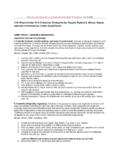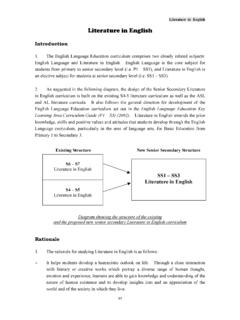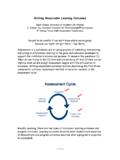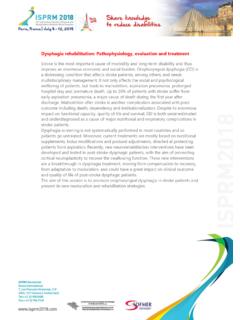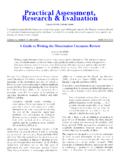Transcription of SWOT and PESTEL production - Home page | UNICEF
1 swot AND PESTEL / Understanding your external and internal context for better planning and decision-making / WHAT ARE swot AND PESTEL ? swot and PESTEL are analytical tools that help identify the key external and internal factors that should be taken into account in order to achieve success in a project or initiative. They are usually used together, and are applied in a group setting to support effective strategic planning, decision-making and action planning. swot and PESTEL are cost- and time-efficient means for highlighting key issues relating to the context of a project or initiative which, if not identified and addressed, could critically affect the chances of success.
2 They also offer the benefit of framing these issues in a way that is easy for participants to understand and discuss. REQUIREMENTS FOR swot : Experienced facilitator Rapporteur. Flip chart with plenty of paper and marker pens. Optional: Laptop and projector. 8 - 12 participants representing diverse relevant roles and ideally including decision- makers. (Alternatively, up to 40 participants if using subgroups; see Variations below.) 1 hour for quick swot ; 2 hours for normal swot , or up to a half-day swot workshop for major initiatives; plus preparation time. ADDITIONAL REQUIREMENTS, IF ADDING PESTEL : 1 - 6 persons with good research/analysis skills, to conduct initial research on the six PESTEL domains before the meeting and also participate at the meeting (they do count against the suggested limit of 12 participants).
3 1 - 2 hours to review, expand and rank PESTEL inputs from research, before continuing with swot . 2 | swot and PESTEL / Tools / UNICEF KE Toolbox WHEN AND WHY TO USE swot : Turning around the order for better results The term swot refers to Strengths, weaknesses , Opportunities, and Threats. Strengths and weaknesses are internal factors: they exist inside the organization (or within the partnership, if relevant to the project being analysed). Opportunities and threats are external: They exist outside the organization. swot is a widely used and fairly well-known tool; the method described here incorporates a couple of changes from the ordinary swot , intended to produce the strongest possible results.
4 swot has often been done in the order implied by the name: first examining strengths, then weaknesses , opportunities and finally threats. However, it is recommended instead to first examine the external factors opportunities and threats and then proceed to the internal ones. This helps keep a stronger focus on results, and helps you identify which threats are critical threats ( those that are compounded by corresponding weaknesses ) and which opportunities are promising opportunities ( those that are matched by corresponding strengths). Those who have changed the order of work in swot , by examining opportunities and threats first, often report being amazed at the improvement in the value of the swot process.
5 1 Any project/initiative that is to be assessed using swot must have clearly defined objectives which are well understood by participants. Clear objectives are a kind of lens, through which the various external and internal factors relevant to your project can be identified as Strengths or weaknesses , Opportunities or Threats. If the objectives seem to be unclear, then have them clarified and agreed before embarking on a swot . The swot framework can be thought of as a matrix. Here it is presented with external factors first. Favourable for achieving the objectives Unfavourable for achieving the objectivesExternal origin Opportunities Threats Internal origin Strengths weaknesses PESTEL : A powerful complement to swot PESTEL , a complementary tool to swot , expands on the analysis of external context by looking in detail at specific types of issues that frequently have an impact on implementation of project/ initiatives.
6 The term PESTEL refers to the domains it considers: Political, Economic, Social, Technological, Environmental and Legal. PESTEL involves identifying the factors in each of these six domains that are relevant for the project being considered. A special focus of PESTEL is identifying trends. Thus it is helpful for thinking proactively and anticipating change, rather than being overtaken by it. It is recommended to use PESTEL and swot together. PESTEL complements swot by 1 For example, see Michael Watkins, From swot to TOWS: Answering a Reader s Strategy Question , in Harvard Business Review online, .. swot and PESTEL / Tools / UNICEF KE Toolbox| 3 identifying specific relevant factors (such as economic trends, social attitudes, technological developments, etc.)
7 That are significant for the project being considered, and swot then classifies them as either Opportunities or Threats. The more complex your context or operating environment is, the more value PESTEL can offer, by identifying factors that would be missed by swot alone. Applying PESTEL is fairly simple: Of the nine steps to do a swot described below, only steps 2 and 5 are done differently when using PESTEL . An extensive set of PESTEL questions is provided in Annex 2 (see below), to help participants identify more quickly and easily the relevant factors in each of its six domains. If you re short of time, you can just do a swot . But if time permits, then applying PESTEL and swot together results in a stronger analysis, a better understanding of the current situation, and the potential for improved decision-making.
8 Applications and benefits swot (and, where possible, PESTEL ) can be applied for the following purposes: Creating, or helping create, a strategic plan or an action plan when launching a project/initiative. This is perhaps the most common application of swot . Weighing the pros and cons of major decisions. For example, use them to help decide on whether to create or join in a new initiative, to establish a significant new partnership, to implement new methods or tools (technological or non-technological), to help plan a reorganization, to assess use of resources and decide on how to improve operational efficiency, etc. Reviewing positioning on an ongoing project/initiative at a key moments of reflection, identifying needed change in the approach or methods being used, and making adjustments.
9 swot and PESTEL are flexible: They can be applied for planning or decision-making concerning an entire project/initiative, or alternatively it can be used to focus on specific stages or components of a project. For example, if you are working on an immunization campaign, you could address all the various programmatic aspects (supply and cold chain, any needed training of health workers, collaboration with government and partners, public communication, etc.) in a single swot , or you could break out the public communication aspect and deal with that separately from the other aspects. Similarly, swot and PESTEL can be applied to large or small (but significant) projects or decisions.
10 If time is very limited, or for small projects, do a quick swot in an hour (remembering to identify the Opportunities and Threats first, and then the Strengths and weaknesses ). With more time, or for projects/decisions with larger implications, do a full swot and PESTEL in about 3 hours, plus preparation time. With even more time, or for very significant projects/decisions, expand the time accordingly, up to a full day workshop. For a simple issue or question, swot and PESTEL may provide sufficient basis for making final decisions or creating an action plan. For complex questions, swot and PESTEL will at least lay a solid foundation, at low cost, for any further in-depth research and analysis that may be required.











